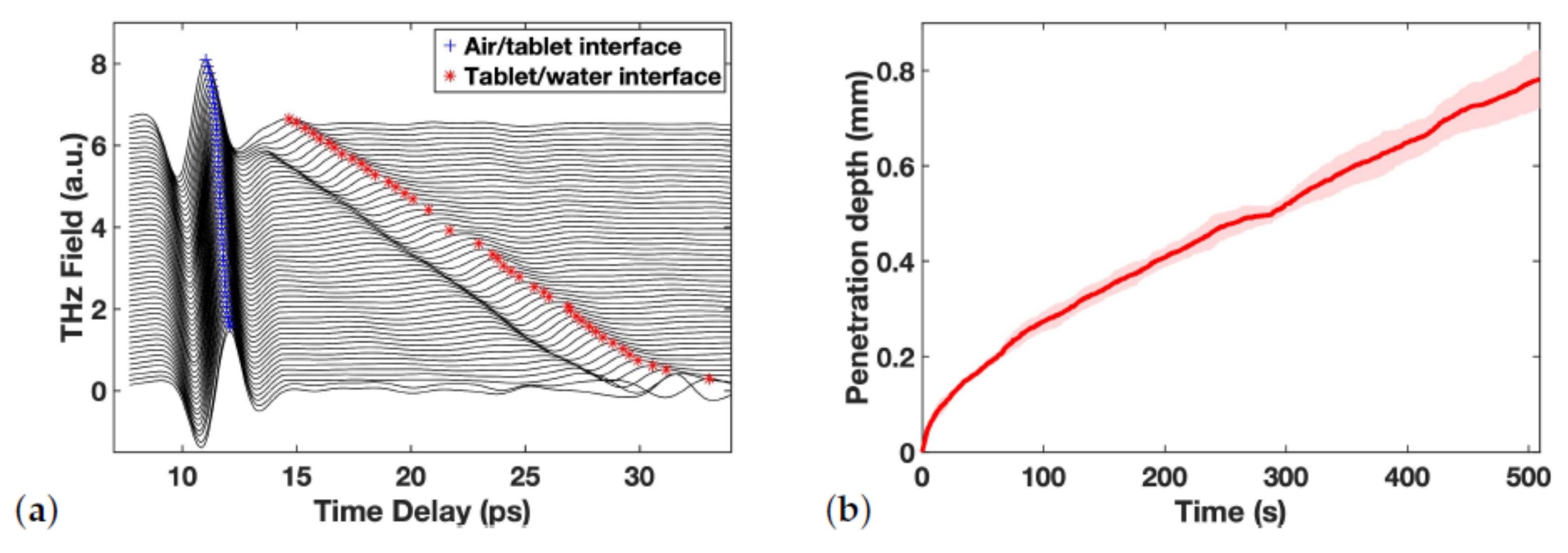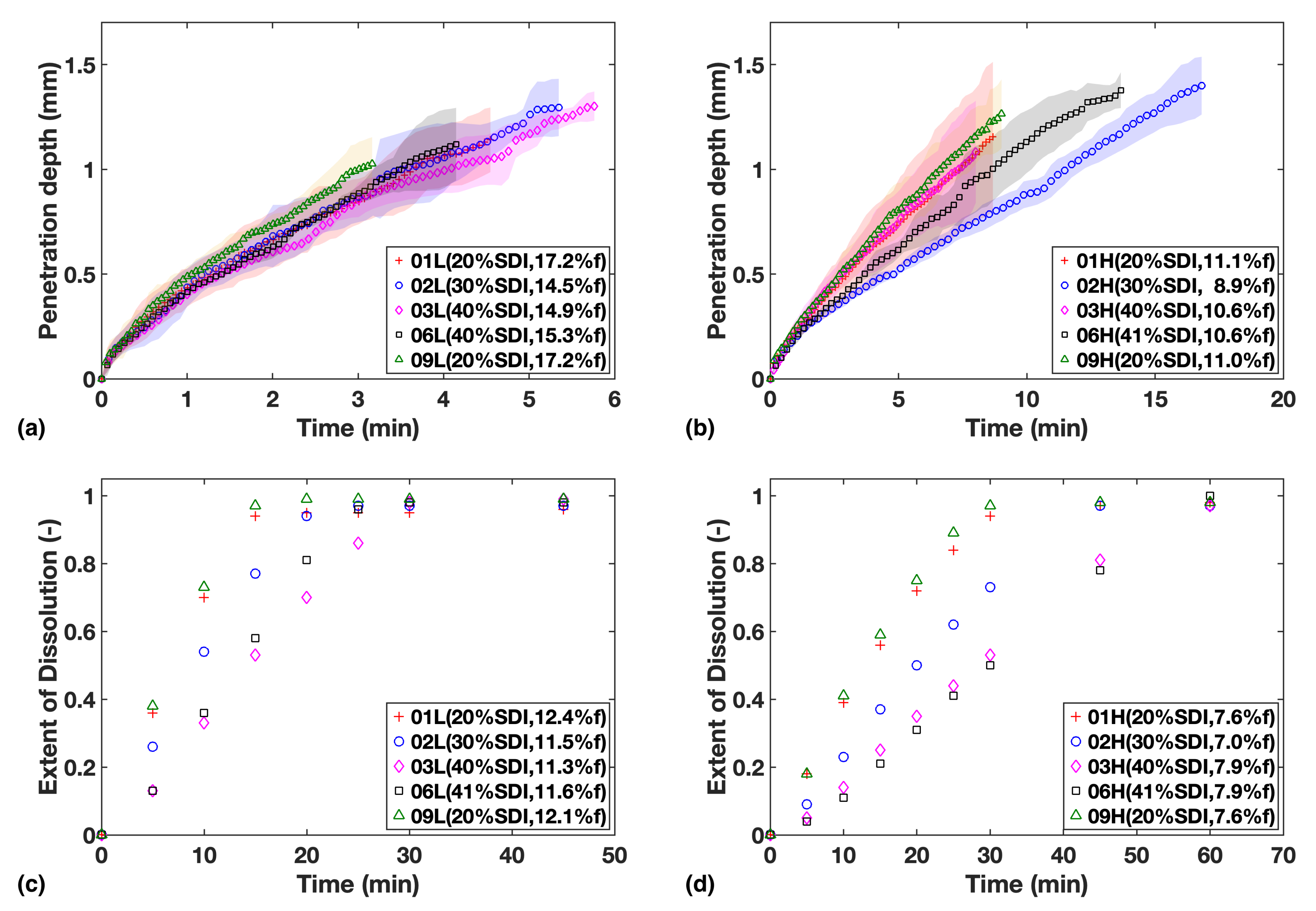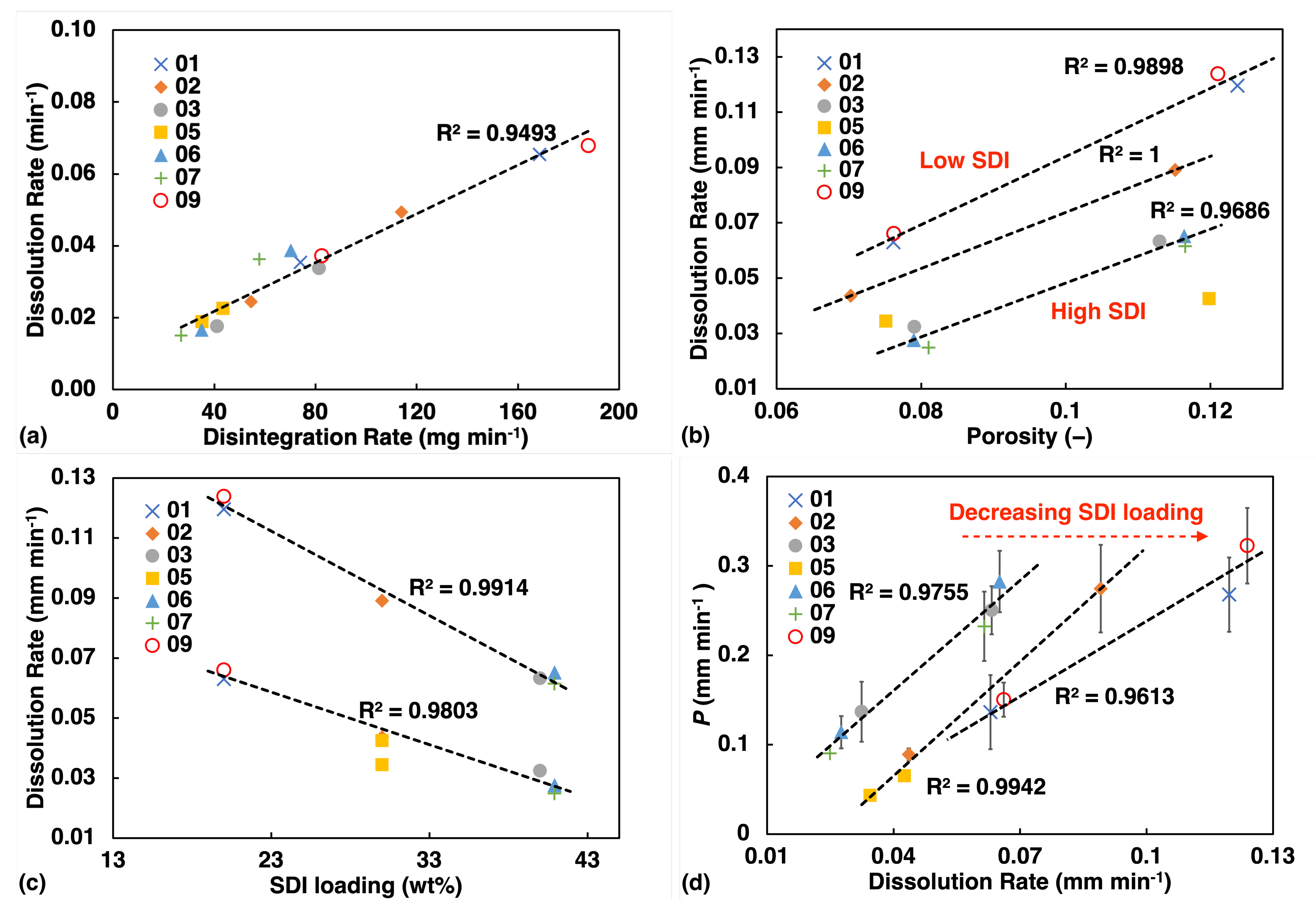Insights into the Control of Drug Release from Complex Immediate Release Formulations
Abstract
:1. Introduction
2. Materials and Methods
2.1. Materials
2.2. Methods
2.2.1. Terahertz Pulsed Imaging (TPI) Experiments
2.2.2. Complementary Testing
3. Results and Discussion
3.1. Liquid Transport Data
3.1.1. Study 1: Investigation of Different Concentrations of SDI
3.1.2. Study 2: Investigation of Different Concentrations of NaCl
3.2. Swelling
3.3. Quantification
3.3.1. Liquid Penetration
3.3.2. Disintegration and Dissolution Test Results
3.3.3. Swelling
3.4. Factorial Analysis
4. Conclusions
Author Contributions
Funding
Data Availability Statement
Acknowledgments
Conflicts of Interest
Appendix A

References
- Markl, D.; Zeitler, J.A. A Review of Disintegration Mechanisms and Measurement Techniques. Pharm. Res. 2017, 34, 890–917. [Google Scholar] [CrossRef] [PubMed] [Green Version]
- Markl, D.; Strobel, A.; Schlossnikl, R.; Bøtker, J.; Bawuah, P.; Ridgway, C.; Rantanen, J.; Rades, T.; Gane, P.; Peiponen, K.E.; et al. Characterisation of Pore Structures of Pharmaceutical Tablets: A Review. Int. J. Pharm. 2018, 538, 188–214. [Google Scholar] [CrossRef] [PubMed] [Green Version]
- Qiu, Y.; Chen, Y.; Zhang, G.G.; Yu, L.; Mantri, R.V. Developing Solid Oral Dosage Forms: Pharmaceutical Theory and Practice, 2nd ed.; Elsevier: Amsterdam, The Netherlands, 2016; pp. 1–1160. [Google Scholar]
- Zheng, J.Y. Formulation and Analytical Development for Low-Dose Oral Drug Products. Formul. Anal. Dev. Low Dose Oral Drug Prod. 2008, 1–461. [Google Scholar] [CrossRef]
- Chen, Y.Y.; Hughes, L.P.; Gladden, L.F.; Mantle, M.D. Quantitative ultra-fast MRI of HPMC swelling and dissolution. J. Pharm. Sci. 2010, 99, 3462–3472. [Google Scholar] [CrossRef] [PubMed]
- Fyfe, C.A.; Blazek, A.I. Investigation of hydrogel formation from hydroxypropylmethylcellulose (HPMC) by NMR spectroscopy and NMR imaging techniques. Macromolecules 1997, 30, 6230–6237. [Google Scholar] [CrossRef]
- Zhang, Q.; Gladden, L.; Avalle, P.; Mantle, M. In vitro quantitative 1H and 19F nuclear magnetic resonance spectroscopy and imaging studies of fluvastatin™ in Lescol® XL tablets in a USP-IV dissolution cell. J. Control. Release 2011, 156, 345–354. [Google Scholar] [CrossRef]
- Segale, L.; Giovannelli, L.; Pattarino, F.; Conti, S.; Maggi, L.; Grenier, P.; Guy, V. Thermogravimetric investigation of the hydration behaviour of hydrophilic matrices. J. Pharm. Sci. 2010, 99, 2070–2079. [Google Scholar] [CrossRef]
- Salsa, T.; Veiga, F.; Teixeira-Dias, J.J.; Pina, M.E. Effect of polymer hydration on the kinetic release of drugs: A study of ibuprofen and ketoprofen in HPMC matrices. Drug Dev. Ind. Pharm. 2003, 29, 289–297. [Google Scholar] [CrossRef] [PubMed] [Green Version]
- Kazarian, S.G.; Van Der Weerd, J. Simultaneous FTIR spectroscopic imaging and visible photography to monitor tablet dissolution and drug release. Pharm. Res. 2008, 25, 853–860. [Google Scholar] [CrossRef] [Green Version]
- Kazarian, S.G.; Chan, K.L. Applications of ATR-FTIR spectroscopic imaging to biomedical samples. Biochim. Biophys. Acta Biomembr. 2006, 1758, 858–867. [Google Scholar] [CrossRef] [Green Version]
- Van Der Weerd, J.; Kazarian, S.G. Combined approach of FTIR imaging and conventional dissolution tests applied to drug release. J. Control. Release 2004, 98, 295–305. [Google Scholar] [CrossRef] [PubMed]
- Sun, Y.; Østergaard, J. Application of UV Imaging in Formulation Development. Pharm. Res. 2016, 1–12. [Google Scholar] [CrossRef] [PubMed]
- Zeitler, J.A. Pharmaceutical Terahertz Spectroscopy and Imaging. In Analytical Techniques in the Pharmaceutical Science; Springer: New York, NY, USA, 2016; pp. 171–222. [Google Scholar] [CrossRef]
- Al-Sharabi, M.; Markl, D.; Vivacqua, V.; Bawuah, P.; MacLean, N.; Bentley, M.; York, A.P.; Marigo, M.; Huang, K.; Zeitler, J.A. Terahertz pulsed imaging as a new method for investigating the liquid transport kinetics of α-alumina powder compacts. Chem. Eng. Res. Des. 2021, 165, 386–397. [Google Scholar] [CrossRef]
- Yassin, S.; Goodwin, D.J.; Anderson, A.; Sibik, J.; Wilson, D.I.; Gladden, L.F.; Zeitler, J.A. The Disintegration Process in Microcrystalline Cellulose Based Tablets, Part 1: Influence of Temperature, Porosity and Superdisintegrants. J. Pharm. Sci. 2015, 104, 3440–3450. [Google Scholar] [CrossRef] [PubMed] [Green Version]
- Markl, D.; Wang, P.; Ridgway, C.; Karttunen, A.P.; Bawuah, P.; Ketolainen, J.; Gane, P.; Peiponen, K.E.; Zeitler, J.A. Resolving the Rapid Water Absorption of Mesoporous Functionalised Calcium Carbonate Powder Compacts by Terahertz Pulsed Imaging. Chem. Eng. Res. Des. 2017, 1–10. [Google Scholar] [CrossRef]
- Markl, D.; Yassin, S.; Wilson, D.I.; Goodwin, D.J.; Anderson, A.; Zeitler, J.A. Mathematical modelling of liquid transport in swelling pharmaceutical immediate release tablets. Int. J. Pharm. 2017, 526, 1–10. [Google Scholar] [CrossRef]
- Bi, Y.X.; Sunada, H.; Yonezawa, Y.; Danjo, K. Evaluation of rapidly disintegrating tablets prepared by a direct compression method. Drug Dev. Ind. Pharm. 1999, 25, 571–581. [Google Scholar] [CrossRef]
- Démuth, B.; Nagy, Z.K.; Balogh, A.; Vigh, T.; Marosi, G.; Verreck, G.; Van Assche, I.; Brewster, M.E. Downstream processing of polymer-based amorphous solid dispersions to generate tablet formulations. Int. J. Pharm. 2015, 486, 268–286. [Google Scholar] [CrossRef]
- Bose, S.; Bogner, R.H. Solventless photocurable film coating: Evaluation of drug release, mechanical strength, and photostability. AAPS PharmSciTech 2007, 8. [Google Scholar] [CrossRef] [Green Version]
- Missaghi, S.; Patel, P.; Farrell, T.P.; Rajabi-Siahboomi, A.R. The Influence of Level and Location of NaCl on Performance of Push-Pull Osmotic Pump Tablets of a Practically Water Insoluble Model Drug Tablets. AAPS PharmSciTech 2014, 15, 149–160. [Google Scholar] [CrossRef] [Green Version]
- Hughey, J.R.; Keen, J.M.; Miller, D.A.; Kolter, K.; Langley, N.; McGinity, J.W. The use of inorganic salts to improve the dissolution characteristics of tablets containing Soluplus®-based solid dispersions. Eur. J. Pharm. Sci. 2013, 48, 758–766. [Google Scholar] [CrossRef]
- Kajiyama, A.; Takagi, H.; Moribe, K.; Yamamoto, K. Improvement of HPMC tablet disintegration by the addition of inorganic salts. Chem. Pharm. Bull. 2008, 56, 598–601. [Google Scholar] [CrossRef] [Green Version]
- Chen, Y.C.; Ho, H.O.; Liu, D.Z.; Siow, W.S.; Sheu, M.T. Swelling/floating capability and drug release characterizations of gastroretentive drug delivery system based on a combination of hydroxyethyl cellulose and sodium carboxymethyl cellulose. PLoS ONE 2015, 10. [Google Scholar] [CrossRef] [PubMed]
- Xi, H.; Ren, J.; Novak, J.M.; Kemp, E.; Johnson, G.; Klinzing, G.; Johnson, M.A.; Xu, W. The Effect of Inorganic Salt on Disintegration of Tablets with High Loading of Amorphous Solid Dispersion Containing Copovidone. Pharm. Res. 2020, 37. [Google Scholar] [CrossRef]
- Mitchell, K.; Ford, J.L.; Armstrong, D.J.; Elliott, P.N.; Rostron, C.; Hogan, J.E. The influence of additives on the cloud point, disintegration and dissolution of hydroxypropylmethylcellulose gels and matrix tablets. Int. J. Pharm. 1990, 66, 233–242. [Google Scholar] [CrossRef]
- Joshi, S.C. Sol-gel behavior of hydroxypropyl methylcellulose (HPMC) in ionic media including drug release. Materials 2011, 4, 1861–1905. [Google Scholar] [CrossRef] [PubMed] [Green Version]
- Blaustein, M.P.; Leenen, F.H.; Chen, L.; Golovina, V.A.; Hamlyn, J.M.; Pallone, T.L.; van Huysse, J.W.; Zhang, J.; Gil Wier, W. How naCl raises blood pressure: A new paradigm for the pathogenesis of salt-dependent hypertension. Am. J. Physiol. Heart Circ. Physiol. 2012, 302. [Google Scholar] [CrossRef] [Green Version]
- World Health Organization—WHO. Sodium Intake for Adults and Children; Technical Report; WHO: Geneva, Switzerland, 2012. [Google Scholar]
- Yuasa, H.; Nakano, T.; Kanaya, Y. Suppression of agglomeration in fluidized bed coating I. Suppression of agglomeration by adding NaCl. Int. J. Pharm. 1997, 158, 195–201. [Google Scholar] [CrossRef]







| Key Ingredients (wt%) | F01 | F02 | F03 | F05 | F06 | F07 | F09 |
|---|---|---|---|---|---|---|---|
| API1 (ruzasvir SDI) | 20.00 | 30.00 | 40.00 | 30.00 | 40.91 | 40.90 | 20.00 |
| API2 (uprifosbuvir) | 15.00 | 15.00 | 15.00 | 15.00 | 20.45 | 20.50 | 10.00 |
| Sodium chloride | 10.00 | 10.00 | 10.00 | 0.00 | 10.00 | 5.00 | 10.00 |
| Mannitol | 14.23 | 10.85 | 7.46 | 14.18 | 5.34 | 7.00 | 15.90 |
| Microcrystalline cellulose | 28.46 | 21.69 | 14.92 | 28.36 | 10.67 | 14.00 | 31.80 |
| Colloidal silicon dioxide | 0.307 | 0.460 | 0.610 | 0.460 | 0.627 | 0.600 | 0.310 |
| Study 1: SDI | X | X | X | X | X | ||
| Study 2: NaCl | X | X | X | X |
| Formulation | True Density | Porosity | Porosity |
|---|---|---|---|
| (g mL−1) | Low Compaction (-) | High Compaction (-) | |
| F01 | 1.453 | 0.1718 ± 0.0013 | 0.1110 ± 0.0033 |
| F02 | 1.414 | 0.1445 ± 0.0021 | 0.0894 ± 0.0043 |
| F03 | 1.378 | 0.1488 ± 0.0041 | 0.1059 ± 0.0021 |
| F05 | 1.378 | 0.1529 ± 0.0018 | 0.0988 ± 0.0026 |
| F06 | 1.364 | 0.1534 ± 0.0027 | 0.1059 ± 0.0076 |
| F07 | 1.347 | 0.1489 ± 0.0049 | 0.1014 ± 0.0026 |
| F09 | 1.463 | 0.1720 ± 0.0010 | 0.1100 ± 0.0053 |
| Y | p-Value | p-Value | p-Value | p-Value | p-Value | |||||
|---|---|---|---|---|---|---|---|---|---|---|
| (Porosity) | 30.24 | <0.0001 | 26.52 | <0.0001 | −25.00 | 0.0077 | 13.16 | 0.1446 | −3.397 | 0.7150 |
| (SDI) | −6.220 | <0.0001 | 1.065 | 0.4076 | −2.312 | 0.3656 | −3.999 | 0.1693 | −5.914 | 0.0716 |
| (NaCl) | 9.207 | 0.0026 | 13.51 | 0.0009 | −4.021 | 0.4972 | 7.305 | 0.2742 | 5.525 | 0.4396 |
| 0.9248 | 0.8839 | 0.5446 | 0.4426 | 0.3411 | ||||||
| ANOVA p-value | <0.0001 | <0.0001 | 0.0417 | 0.1063 | 0.2247 |
Publisher’s Note: MDPI stays neutral with regard to jurisdictional claims in published maps and institutional affiliations. |
© 2021 by the authors. Licensee MDPI, Basel, Switzerland. This article is an open access article distributed under the terms and conditions of the Creative Commons Attribution (CC BY) license (https://creativecommons.org/licenses/by/4.0/).
Share and Cite
Dong, R.; DiNunzio, J.C.; Regler, B.P.; Wasylaschuk, W.; Socia, A.; Zeitler, J.A. Insights into the Control of Drug Release from Complex Immediate Release Formulations. Pharmaceutics 2021, 13, 933. https://doi.org/10.3390/pharmaceutics13070933
Dong R, DiNunzio JC, Regler BP, Wasylaschuk W, Socia A, Zeitler JA. Insights into the Control of Drug Release from Complex Immediate Release Formulations. Pharmaceutics. 2021; 13(7):933. https://doi.org/10.3390/pharmaceutics13070933
Chicago/Turabian StyleDong, Runqiao, James C. DiNunzio, Brian P. Regler, Walter Wasylaschuk, Adam Socia, and J. Axel Zeitler. 2021. "Insights into the Control of Drug Release from Complex Immediate Release Formulations" Pharmaceutics 13, no. 7: 933. https://doi.org/10.3390/pharmaceutics13070933
APA StyleDong, R., DiNunzio, J. C., Regler, B. P., Wasylaschuk, W., Socia, A., & Zeitler, J. A. (2021). Insights into the Control of Drug Release from Complex Immediate Release Formulations. Pharmaceutics, 13(7), 933. https://doi.org/10.3390/pharmaceutics13070933







